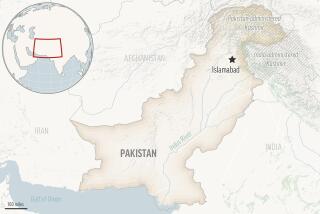Avalanche buries Pakistan base; 117 soldiers feared dead
- Share via
ISLAMABAD, Pakistan — They serve on a remote Himalayan glacier known as the world’s highest combat zone, in a fiercely disputed region that has sparked two wars between archrivals Pakistan and India. But instead of dying in battle, 117 Pakistani soldiers were feared lost Saturday in a massive avalanche that entombed their lonely headquarters.
Most of the soldiers were believed to have been in the battalion’s main building when the avalanche struck about 6 a.m., burying the men under 70 feet of snow, Pakistani military officials said.
The military launched a large-scale rescue mission that included hundreds of soldiers, five military helicopters, search dogs, bulldozers, engineers and medical teams, said Pakistani army spokesman Maj. Gen. Athar Abbas and other military officials.
But by Saturday evening, there still was no word of survivors, Abbas said. The snow-blanketed mountainous terrain made access to the site, at 15,000 feet elevation, extremely difficult.
“It’s a very big avalanche and it covered a lot of area,” Abbas said. No communication had been established with the trapped soldiers and no bodies recovered, he said.
Later in the evening, Abbas told the BBC, “We are hoping against hope. We are keeping our fingers crossed…. But so far we have not received any good news from the area.”
Prime Minister Yousuf Raza Gilani released a statement expressing shock, but saying that the incident “in no way would undermine the high morale of soldiers and officers.”
The soldiers were deployed on the Siachen Glacier on the far northern end of the disputed Kashmir region claimed by both India and Pakistan.
Soldiers have been deployed there at elevations as high as 22,000 feet, and have had to endure extremely harsh conditions, including an average winter snowfall of 35 feet and temperatures as low as minus 50 degrees. Far more soldiers die because of the harsh conditions than from combat.
Avalanches in the Siachen region are relatively common, and soldiers deployed in the area are trained in avalanche survival and rescue techniques, Abbas said. But they are much more infrequent near the headquarters hit by the avalanche Saturday, a rear base for Pakistan’s outposts in the region.
The dispute over the broader Kashmir region remains one of the primary obstacles impeding normalization of relations between India and Pakistan. It has been the point of contention in two of the three wars the countries have fought since their independence from Britain in 1947.
Since 1984, when India established a military foothold on the 49-mile-long glacier, skirmishes have broken out several times.
India is believed to have as many as 5,000 soldiers in the Siachen region; Pakistan’s force there is also thought to number in the thousands. The deployments cost both countries millions of dollars a year.
A cease-fire has been in place since 2003, and Saturday’s disaster is likely to prompt questions by some in Pakistan of whether such large troop deployments are necessary in such a remote, inhospitable location, particularly at a time when India and Pakistan have been making progress in improving relations.
President Asif Ali Zardari is slated to have lunch with Indian Prime Minister Manmohan Singh on Sunday in New Delhi, a meeting widely viewed as an important symbolic step in easing tension between the two countries.
More to Read
Sign up for Essential California
The most important California stories and recommendations in your inbox every morning.
You may occasionally receive promotional content from the Los Angeles Times.










